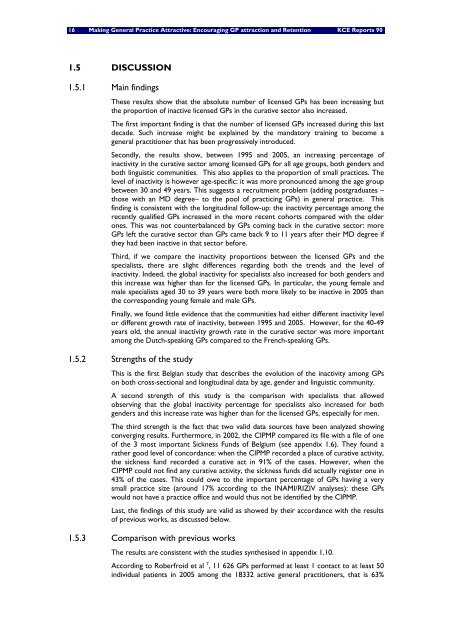Download the report (150 p.) - KCE
Download the report (150 p.) - KCE
Download the report (150 p.) - KCE
You also want an ePaper? Increase the reach of your titles
YUMPU automatically turns print PDFs into web optimized ePapers that Google loves.
16 Making General Practice Attractive: Encouraging GP attraction and Retention <strong>KCE</strong> Reports 90<br />
1.5 DISCUSSION<br />
1.5.1 Main findings<br />
These results show that <strong>the</strong> absolute number of licensed GPs has been increasing but<br />
<strong>the</strong> proportion of inactive licensed GPs in <strong>the</strong> curative sector also increased.<br />
The first important finding is that <strong>the</strong> number of licensed GPs increased during this last<br />
decade. Such increase might be explained by <strong>the</strong> mandatory training to become a<br />
general practitioner that has been progressively introduced.<br />
Secondly, <strong>the</strong> results show, between 1995 and 2005, an increasing percentage of<br />
inactivity in <strong>the</strong> curative sector among licensed GPs for all age groups, both genders and<br />
both linguistic communities. This also applies to <strong>the</strong> proportion of small practices. The<br />
level of inactivity is however age-specific: it was more pronounced among <strong>the</strong> age group<br />
between 30 and 49 years. This suggests a recruitment problem (adding postgraduates –<br />
those with an MD degree– to <strong>the</strong> pool of practicing GPs) in general practice. This<br />
finding is consistent with <strong>the</strong> longitudinal follow-up: <strong>the</strong> inactivity percentage among <strong>the</strong><br />
recently qualified GPs increased in <strong>the</strong> more recent cohorts compared with <strong>the</strong> older<br />
ones. This was not counterbalanced by GPs coming back in <strong>the</strong> curative sector: more<br />
GPs left <strong>the</strong> curative sector than GPs came back 9 to 11 years after <strong>the</strong>ir MD degree if<br />
<strong>the</strong>y had been inactive in that sector before.<br />
Third, if we compare <strong>the</strong> inactivity proportions between <strong>the</strong> licensed GPs and <strong>the</strong><br />
specialists, <strong>the</strong>re are slight differences regarding both <strong>the</strong> trends and <strong>the</strong> level of<br />
inactivity. Indeed, <strong>the</strong> global inactivity for specialists also increased for both genders and<br />
this increase was higher than for <strong>the</strong> licensed GPs. In particular, <strong>the</strong> young female and<br />
male specialists aged 30 to 39 years were both more likely to be inactive in 2005 than<br />
<strong>the</strong> corresponding young female and male GPs.<br />
Finally, we found little evidence that <strong>the</strong> communities had ei<strong>the</strong>r different inactivity level<br />
or different growth rate of inactivity, between 1995 and 2005. However, for <strong>the</strong> 40-49<br />
years old, <strong>the</strong> annual inactivity growth rate in <strong>the</strong> curative sector was more important<br />
among <strong>the</strong> Dutch-speaking GPs compared to <strong>the</strong> French-speaking GPs.<br />
1.5.2 Strengths of <strong>the</strong> study<br />
This is <strong>the</strong> first Belgian study that describes <strong>the</strong> evolution of <strong>the</strong> inactivity among GPs<br />
on both cross-sectional and longitudinal data by age, gender and linguistic community.<br />
A second strength of this study is <strong>the</strong> comparison with specialists that allowed<br />
observing that <strong>the</strong> global inactivity percentage for specialists also increased for both<br />
genders and this increase rate was higher than for <strong>the</strong> licensed GPs, especially for men.<br />
The third strength is <strong>the</strong> fact that two valid data sources have been analyzed showing<br />
converging results. Fur<strong>the</strong>rmore, in 2002, <strong>the</strong> CIPMP compared its file with a file of one<br />
of <strong>the</strong> 3 most important Sickness Funds of Belgium (see appendix 1.6). They found a<br />
ra<strong>the</strong>r good level of concordance: when <strong>the</strong> CIPMP recorded a place of curative activity,<br />
<strong>the</strong> sickness fund recorded a curative act in 91% of <strong>the</strong> cases. However, when <strong>the</strong><br />
CIPMP could not find any curative activity, <strong>the</strong> sickness funds did actually register one in<br />
43% of <strong>the</strong> cases. This could owe to <strong>the</strong> important percentage of GPs having a very<br />
small practice size (around 17% according to <strong>the</strong> INAMI/RIZIV analyses): <strong>the</strong>se GPs<br />
would not have a practice office and would thus not be identified by <strong>the</strong> CIPMP.<br />
Last, <strong>the</strong> findings of this study are valid as showed by <strong>the</strong>ir accordance with <strong>the</strong> results<br />
of previous works, as discussed below.<br />
1.5.3 Comparison with previous works<br />
The results are consistent with <strong>the</strong> studies syn<strong>the</strong>sised in appendix 1.10.<br />
According to Roberfroid et al 7 , 11 626 GPs performed at least 1 contact to at least 50<br />
individual patients in 2005 among <strong>the</strong> 18332 active general practitioners, that is 63%
















